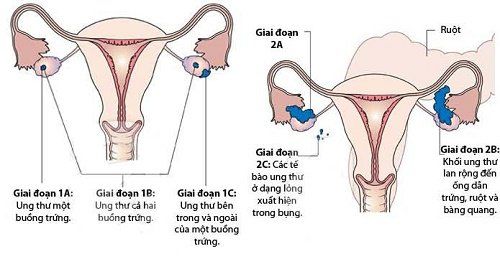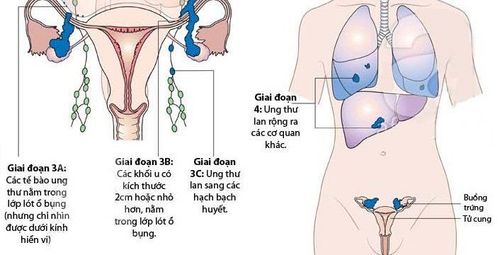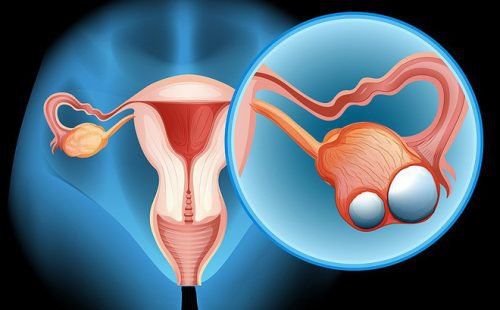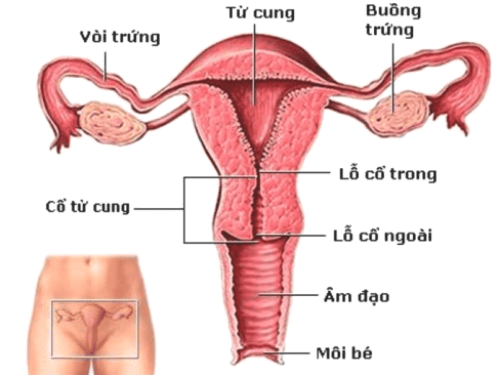This is an automatically translated article.
Ovarian cancer is a malignant tumor that occurs in the ovaries, which produce egg cells and secrete the female sex hormones estrogen and progestogen. Most ovarian cancer patients are detected at an advanced stage. As soon as the disease is detected, the first thing the doctor cannot ignore is to determine the stage of the disease, from which to give the appropriate treatment regimen. This article will help you better understand the 4 stages of ovarian cancer.Ovarian cancer is classified into stages based on how far it has spread, helping patients and doctors decide on the best course of treatment. Ovarian cancer progresses in the following 4 stages:
1. Ovarian cancer stage 1

Ung thư buồng trứng giai đoạn 1 và 2
Stage 1A: This stage cancer cells begin to form and grow inside an ovary or fallopian tube. At this time, the malignant cancer cells have not appeared and have not penetrated beyond the ovary. Stage 1B: At this time, the cancer has not appeared on the outer surface of the ovary and there are no malignant cells, but the tumor has begun to appear in both ovaries. Stage 1C: Tumors in the 2 above stages begin to appear one of the following: Appears on the outer surface of one or both ovaries. The capsules were broken. Malignant cells have begun to appear. When ovarian cancer is detected at stage 1, if you follow the right method and treatment process of the doctor, the patient has up to 90% chance to live over 5 years.
2. Ovarian cancer stage 2
In stage 2, the tumor is still in the ovary and fallopian tube, but the cancer cells have invaded to the organs adjacent to the ovary in the pelvis such as uterus, fallopian tubes... Stage 2 This means that the tumor has actually made contact and spread to other nearby organs.Stage 2A: Cancer has spread to the uterus, fallopian tubes, or both. Stage 2B: Cancer has spread to other nearby pelvic organs such as the colon, rectum, or bladder. Stage 2C: Cancer has spread to the uterus, fallopian tubes, and uterus. other pelvic tissues (as in 2A or 2B). According to the prognosis of experts, the 5-year survival time of ovarian cancer patients of this stage is 70%. Therefore, even though the patient has stage 2 ovarian cancer, there is still a lot of hope. It is important to always follow your doctor's treatment plan for the best results.
3. Ovarian cancer stage 3

Ung thư buồng trứng giai đoạn 3 và 4
When ovarian cancer enters stage 3, the cancer has spread to other organs in the abdomen such as the ovaries, the lining of the abdomen, ... or the system of lymph nodes in the abdomen. According to statistics, up to 51% of cases diagnosed with ovarian cancer have entered stage 3 of the disease.
Stage 3A: By the time you get to stage 3A, cancer may already be present in both ovaries. Although cancer cells in the abdomen or lymph nodes cannot be seen with the naked eye, when examined with a microscope, signs of cancer in the abdomen can be observed. Stage 3B: The tumor has grown and is visible to the naked eye at surgery (about 2cm or less in diameter). They may also have spread to the lymph nodes but have not yet appeared in distant organs such as the liver, spleen... Stage 3C: This time the tumor has spread from the pelvis to the abdomen and is larger. 2cm. It may even have reached the surface of more distant organs such as the liver and spleen. It may or may not be present in the lymph nodes. At this stage, the 5-year survival rate decreased to 39%.
4. Ovarian cancer stage 4
Stage 4 is the most advanced stage of ovarian cancer. At this time, the treatment will be very difficult and expensive, because the tumor has metastasized to the liver and external organs of the abdomen and even has the appearance of cancer cells in the pleural fluid (from the abdominal cavity). surrounds the lungs).
Stage 4A: This is when cancer cells are found in the fluid around the lungs. Stage 4B: Cancer cells have moved even further into the spleen, liver, lungs, brain, or other organs away from the original tumor, as well as to lymph nodes located in the groin. In the last stage of ovarian cancer in patients, the treatment will be very difficult and the effect is not clear because the tumor has metastasized far. After determining the patient's stage, the doctor will come up with a treatment plan. Treatment for ovarian cancer depends on many factors, including the course of the disease and the patient's general health. Patients are often treated with many different methods such as surgical resection, radiation therapy, chemotherapy... Depending on the specific case, the doctor will appoint one or a combination of multiple treatment methods to increase the effectiveness. treatment results.
The treatment of ovarian cancer depends very much on the stage of the disease, which is also a determining factor in the patient's prognosis. Doctors recommend that women should have regular check-ups every 6 months to check their health, the earlier the disease is detected, the higher the success rate of treatment.
Gynecological cancer screening and early detection package of Vinmec International General Hospital helps to detect ovarian cancer early even when there are no symptoms; is performed by a team of highly qualified and experienced doctors, fully equipped with specialized facilities to diagnose the disease and stage it before treatment, especially in the treatment of ovarian cancer.
When registering for Gynecological Cancer Screening and Early Detection Package, customers will receive:
Examination and consultation with a specialist in Obstetrics and Gynecology. Cervical cancer screening by tests such as cytology by Liqui Prep method, automated system HPV genotype PCR test, transvaginal ultrasound test of uterus and ovaries.
Please dial HOTLINE for more information or register for an appointment HERE. Download MyVinmec app to make appointments faster and to manage your bookings easily.













